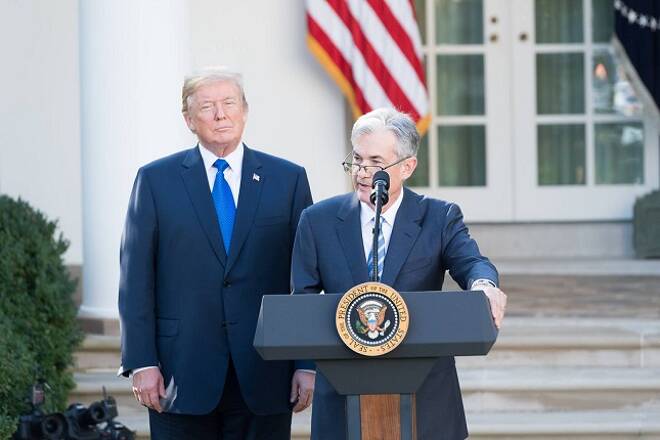Advertisement
Advertisement
The Mid-Week Market Themes: Oil Prices, Powell, Sterling Woes, COVID-19, and Geopolitics in Focus
By:
It's been a busy week thus far, with Powell adding to the risk aversion mid-week. COVID-19 jitters are likely to persist as the tension between China and the U.S lingers
The second week of May was not very busy for the US Dollar, as there were not many macroeconomic data publications.
Meanwhile, what should we expect from the Fed Chair Powell’s Scheduled Speech?
We’ve seen a number of records broken of late and all for the wrong reasons. Last week, the FFR prices in negative rates for the 1st time in history.
Having previously spoken of negative rates, U.S President Trump talked once more of negative rates this week. The U.S administration would certainly benefit from such a move considering the current environment and ballooning debt.
Powell, however, will likely talk down any chances of negative rates near-term. Any chatter of negative rates could also spook the markets. Zero rates are one thing, but negative rates are another story altogether…
Expect the FED Chair to be on the dovish side, however. Plenty of uncertainty remains over what lies ahead and the FED’s job is far from done.
While lockdown measures are easing, there will be concern over unemployment and inflation and the speed with which the markets are expecting the economy to recover…
As always, the FED Chair Chatter seems to be an important event to pay attention to.
In the meantime, let us discuss the commonwealth currencies. What about the New Zealand Dollar?
We saw the Kiwi Dollar take a hit in response to the RBNZ monetary policy decision on Wednesday.
While the RBNZ held the cash rate unchanged at 0.25%, the Large Scale Asset Purchasing Programme was expanded from NZ$33bn to NZ$60bn.
The Committee also talked down the likelihood of a near-term economic recovery after the containment of the virus.
The general tone suggested that more support would likely be needed that put negative rates back on the table.
Much will depend, however, on New Zealand’s trading partners and progress on containing the virus and easing lockdown measures.
That suggests greater Kiwi Dollar sensitivity to economic data from the likes of China and the U.S near-term…
Seems like market participants should continue to watch RBNZ releases closely.
What about commodities like oil?
While we have seen oil prices steady this week, a supply and demand imbalance looks likely to linger, however.
Until this is remedied, which is no easy task, any material upside in crude would likely be limited near-term
There are also downside risks that continue to question the recent rebound. A 2nd wave of the COVID-19 pandemic would certainly send crude oil prices crashing. Any hint of governments planning on reintroducing lockdown measures would also be particularly negative.
At a minimum, demand will need to substantially increase as inventories continue to surge…
On Wednesday, OPEC’s monthly report and the weekly EIA inventory numbers will garner plenty of interest.
It’s not just about the size of production cuts, but actual output forecasts versus demand… OPEC’s report will give some guidance on where things stand.
Let us move on with other major currencies.
Have you heard anything from the UK?
It’s certainly a tough time for the UK and the Pound at the moment.
Brexit negotiations appear to be going nowhere fast raising the chances of either:
- An extension to the transition period, or
- A hard Brexit.
There was talk of the EU wanting the UK to fall under EU laws should there be an extension to the transition period. It’s unlikely that the British government would go for that, which suggests a hard Brexit a more likely outcome as the clock ticks.
There is also the impact of COVID-19 on the British economy. While 1st quarter GDP numbers on Wednesday are likely to be quite dire, it’s the government’s plans on easing lockdown measures that are also Pound negative.
At present, Britain is lagging a number of its neighbors, which suggests more economic doom and gloom, while others begin to recover.
For now, it looks as though the British government has also failed at containment, with the number of virus cases amongst the highest globally. The numbers will need to start falling back for the Pound to get any meaningful support.
It appears that the Pound continues to be under the pressure of Brexit.
Anything else notable in regards to non-macroeconomic data?
Away from the economic calendar, the daily COVID-19 numbers are likely to be the main area of focus for now.
After hearing of new clusters in China, South Korea, Germany, any sudden uptick in new cases will spook the markets.
We are expecting a pickup in new cases as lockdown measures ease. This uptick should be a moderate one, however. Any surge and expect governments to reverse recent steps to ease measures. This would be a particularly dire outcome for the global financial markets and the global economy.
From a U.S perspective, it would certainly be interesting to see how Trump would deal with such a situation. The U.S President had talked of reopening the U.S at all costs…
About the Author
Bob Masonauthor
With over 28 years of experience in the financial industry, Bob has worked with various global rating agencies and multinational banks. Currently he is covering currencies, commodities, alternative asset classes and global equities, focusing mostly on European and Asian markets.
Latest news and analysis
Advertisement
